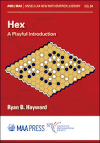- About MAA
- Membership
- MAA Publications
- Periodicals
- Blogs
- MAA Book Series
- MAA Press (an imprint of the AMS)
- MAA Notes
- MAA Reviews
- Mathematical Communication
- Information for Libraries
- Author Resources
- Advertise with MAA
- Meetings
- Competitions
- Programs
- Communities
- MAA Sections
- SIGMAA
- MAA Connect
- Students
- MAA Awards
- Awards Booklets
- Writing Awards
- Teaching Awards
- Service Awards
- Research Awards
- Lecture Awards
- Putnam Competition Individual and Team Winners
- D. E. Shaw Group AMC 8 Awards & Certificates
- Maryam Mirzakhani AMC 10 A Awards & Certificates
- Two Sigma AMC 10 B Awards & Certificates
- Jane Street AMC 12 A Awards & Certificates
- Akamai AMC 12 B Awards & Certificates
- High School Teachers
- News
You are here
Hex: A Playful Introduction

Buy Now:
Publisher:
AMS
Publication Date:
2022
Number of Pages:
124
Format:
Paperback
Price:
35.00
ISBN:
978-1-4704-6492-9
Category:
Monograph
[Reviewed by , on ]
Tom French
10/4/2022
Professor Hayward has compiled a thought-provoking book for those interested in games and puzzles. The author examines the board game Hex. Hex is a two-player game with a simple set of rules. The board used for Hex is unlike the square boards with the square cells that we are accustomed to in games like Chess or Go. Rather, the Hex board is a rhombus-shaped board containing hexagonal cells.
The game is played as follows: one player has the black stones while the opposing player has the white stones. The object of the game is to connect opposite sides of the rhombus. The players alternately place their stones on the hexagonal cells. The winning player is the one whose stones connect to form a continuous path from one side of the board to the opposite side.
Hex is normally played on an 11x11-celled rhombus although some players prefer playing the game on the 13x13-celled rhombus or the 19x19-celled rhombus.
Author Hayward has written this book as an introduction to the game Hex. The rules are clearly explained in the beginning of the text and the reader is immediately introduced to strategies and puzzles utilizing 2x2-celled, 3x3-celled, 4x4-celled, and 5x5-celled rhombi. The book “Hex” demonstrates the mathematics of both winning and blundering strategies. Numerous puzzles and their solutions are incorporated throughout the eleven chapters.
Hayward traces the origins of Hex to its very beginning in 1941 when the outspoken anti-Nazi Danish engineer and poet, Piet Hines, went underground after the German invasion of Denmark. Hines invented the game he called Polygon from his experience working on the four-color map problem. Parker Brothers eventually heard about the game after the war, renamed it Hex, and began selling it in boxed sets in 1951.
The final chapters of the book discuss how computers play Hex. The reader is also introduced to a large variety of boards that can be used to play Hex. I was particularly captivated by the geodesic-Y board, which can be used in place of the rhombus board. I could not put the book down until I attempted playing Hex and solving puzzles using the geodesic Y-board.
The book is written so that the non-specialist can readily read, understand, and work the puzzles. However, the expert Hex player and skilled mathematician will also enjoy many of the pearls of wisdom included in this text.
I would recommend this book as a supplement to courses covering topics such as Game Theory or Recreational Mathematics. I also recommend this book for those in a Chess Club, Math Club, and any group studying winning and losing tactics.
Tom French has a B.S. and a M.S. degree in Mathematics from Minnesota State University, Mankato. He has 35 years of engineering and business experience with UNIVAC and its successor companies. He was part of the design team that first implemented medium-scale and large-scale integrated circuits into computers. Tom was the program manager for several large computer innovations and was one of the leaders who implemented the technology revolution into the banking system in the Russian Federation. He has lectured on mathematics and computer systems throughout the world and has taught mathematics at a number of US colleges and universities.
See the publisher's website.
- Log in to post comments




